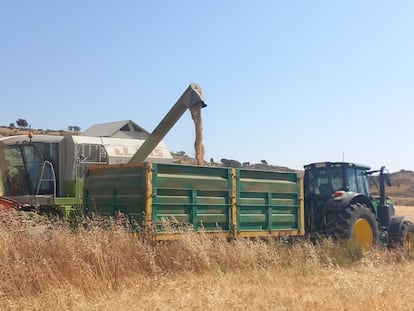Low prices mark the grain market due to the good national and global harvest.


The grain market is not in its best shape for farmers due to a good domestic harvest, a decrease in demand, and, fundamentally, high imports of surpluses from major producing countries, which have all led to a drop in prices.
This season's grain harvest is estimated at a production between the 23 million managed by the Ministry of Agriculture and agricultural organizations, the 24 million by warehouse workers, and the more than 25 million estimated by agri-food cooperatives. This latter figure represents a 15% increase over the 22.5 million produced in the previous season, far from the less than 11 million produced by the drought-stricken 2023 harvest, but also below the record harvest of 27.5 million in 2020.
However, as a result of the good domestic harvest, but also due to massive imports, there has been a drop in prices, according to the Asaja complaint , which has brought the sector below the limits of profitability. The organization claims that, under current market conditions, farmers are losing between 50 and 60 euros per hectare and is calling for greater control over massive imports without guarantees or traceability.
According to cooperative estimates, wheat production will reach 8.2 million tons; just over 10 million tons of barley; 3.6 million tons of corn; 1.3 million tons of oats; 0.73 million tons of durum wheat; 0.3 million tons of rye; and 900,000 tons of other cereals.
Yields per hectare have been high due to the favorable weather conditions in which crops have grown in most areas, reaching over 4,000 kilos of soft wheat and barley and almost 12,000 kilos of corn. This is the result of a campaign so far dominated by favorable conditions from sowing to germination and subsequent development.
With a very large livestock population, especially pigs and poultry, there has traditionally been a strong dependence on foreign raw materials for animal feed production. In 2023, with a minimal harvest of just over 10 million tons due to the drought, imports soared to 24 million tons. This figure is justified considering that total domestic demand stands at between 36 and 37 million tons, of which 27 million correspond to animal feed needs, just over five million to feed, and more than three million to industrial uses.
In the previous campaign, with a harvest of more than 20 million tons, imports fell to 16.5 million tons, half of which was corn and almost the remainder soft wheat.
As a result, prices have been negatively affected, with barley prices falling slightly below €180, feed wheat prices below €200, and durum wheat prices at €260. This situation is compounded by the adjustment of livestock herd censuses and, consequently, lower demand.
Cereals are one of the pillars of agricultural activity, especially throughout continental Spain, with an average area of more than 5.5 million hectares under cultivation and a predominance of medium-sized farms. Aside from the specific incidents each season, the sector also faces other structural problems from production to marketing that affect its profitability.
Regarding agricultural production, official data point to a very high number of independent farms. The development of first-level cooperatives is important, but, with a few exceptions, stronger structures such as second-level entities are lacking to exert greater influence on prices. In marketing, greater organization of supply is essential, as well as a halt to unpriced or simply "as a result" sales operations, where the individual farmer "delegates" to others the protection of the results of his work and, ultimately, his income.

Milk prices have increased by two cents since July to an average of €0.51 per liter, coinciding with a traditional period of lower supply due to high temperatures affecting animal performance and reduced herd sizes. Despite this, the price is five cents below the EU average, according to the Union of Small Farmers. Increases are forecast for September, but this does not slow the adjustment in livestock prices due to low profitability and the lack of generational change.
In recent years, the sector has seen a reduction in dairy cattle farms from 14,000 to fewer than 9,000, and a reduction in the number of cattle in production from nearly 900,000 to fewer than 750,000, although yields per cow have increased.
Data from the producer organization Agaprol indicate that milk production in 2025 will be the lowest in recent years, reaching only 7.38 million tons compared to 7.5 million tons in 2021 and the nine million tons produced in the last decade, compared to a total dairy demand of around 10 million tons. This implies high imports, with more than 300,000 tons of cheese.
The increase in beef prices, especially due to exports, has provided a lifeline for dairy farms with the sale of calves and older cows. This has also led to dairy farms switching to meat-only production, currently due to its greater profitability. But these movements have led to an adjustment in milk supply that, in theory, should have a positive impact on prices. Beef has won the battle against milk.
EL PAÍS

-U24273854127JKL-1024x512%40diario_abc.jpg&w=3840&q=100)



